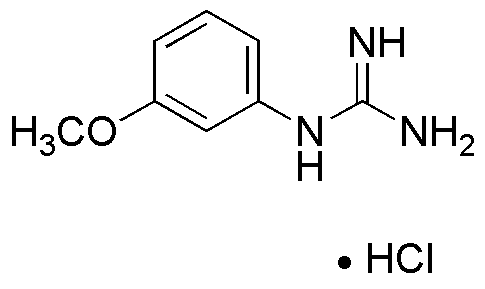N-(3-methoxyphenyl)guanidine hydrochloride is widely utilized in research focused on:
- Pharmaceutical Development: This compound serves as a key intermediate in the synthesis of various pharmaceuticals, particularly those targeting neurological disorders, enhancing drug efficacy and specificity.
- Biochemical Research: It is used in studies related to enzyme inhibition and receptor binding, providing insights into metabolic pathways and potential therapeutic targets.
- Analytical Chemistry: The compound is employed in analytical methods to detect and quantify specific biomolecules, aiding in quality control and research applications.
- Material Science: It finds applications in the development of novel materials with specific properties, such as conductivity or reactivity, useful in electronics and nanotechnology.
- Cosmetic Formulations: This chemical is also explored for its potential benefits in skincare products, offering antioxidant properties that can enhance product effectiveness.
General Information
Properties
Safety and Regulations
Applications
N-(3-methoxyphenyl)guanidine hydrochloride is widely utilized in research focused on:
- Pharmaceutical Development: This compound serves as a key intermediate in the synthesis of various pharmaceuticals, particularly those targeting neurological disorders, enhancing drug efficacy and specificity.
- Biochemical Research: It is used in studies related to enzyme inhibition and receptor binding, providing insights into metabolic pathways and potential therapeutic targets.
- Analytical Chemistry: The compound is employed in analytical methods to detect and quantify specific biomolecules, aiding in quality control and research applications.
- Material Science: It finds applications in the development of novel materials with specific properties, such as conductivity or reactivity, useful in electronics and nanotechnology.
- Cosmetic Formulations: This chemical is also explored for its potential benefits in skincare products, offering antioxidant properties that can enhance product effectiveness.
Documents
Safety Data Sheets (SDS)
The SDS provides comprehensive safety information on handling, storage, and disposal of the product.
Product Specification (PS)
The PS provides a comprehensive breakdown of the product’s properties, including chemical composition, physical state, purity, and storage requirements. It also details acceptable quality ranges and the product's intended applications.
Certificates of Analysis (COA)
Search for Certificates of Analysis (COA) by entering the products Lot Number. Lot and Batch Numbers can be found on a product’s label following the words ‘Lot’ or ‘Batch’.
*Catalog Number
*Lot Number
Certificates Of Origin (COO)
This COO confirms the country where the product was manufactured, and also details the materials and components used in it and whether it is derived from natural, synthetic, or other specific sources. This certificate may be required for customs, trade, and regulatory compliance.
*Catalog Number
*Lot Number
Safety Data Sheets (SDS)
The SDS provides comprehensive safety information on handling, storage, and disposal of the product.
DownloadProduct Specification (PS)
The PS provides a comprehensive breakdown of the product’s properties, including chemical composition, physical state, purity, and storage requirements. It also details acceptable quality ranges and the product's intended applications.
DownloadCertificates of Analysis (COA)
Search for Certificates of Analysis (COA) by entering the products Lot Number. Lot and Batch Numbers can be found on a product’s label following the words ‘Lot’ or ‘Batch’.
*Catalog Number
*Lot Number
Certificates Of Origin (COO)
This COO confirms the country where the product was manufactured, and also details the materials and components used in it and whether it is derived from natural, synthetic, or other specific sources. This certificate may be required for customs, trade, and regulatory compliance.


